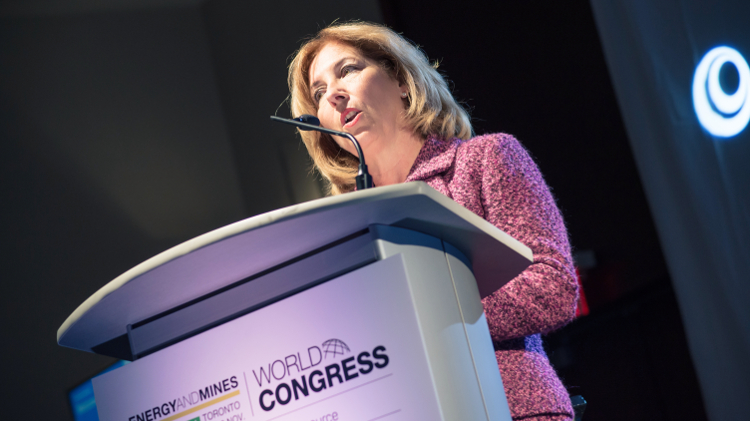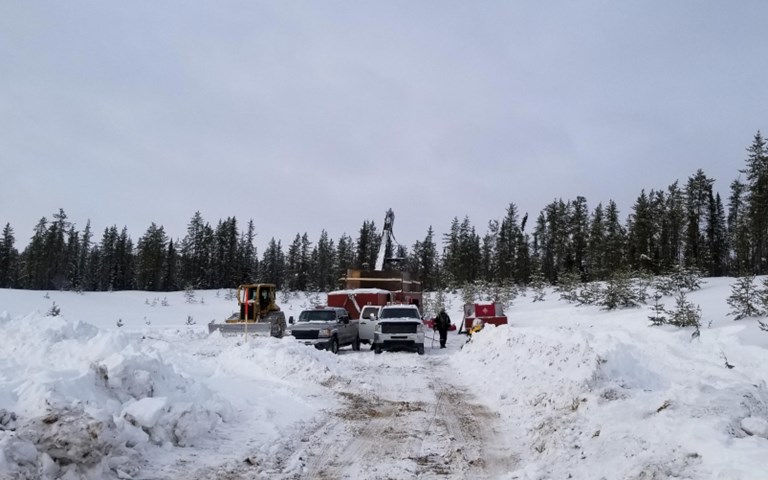Troilus Gold is working with Tugliq Energie to conduct an inventory of all of its currently and historical GHG emissions, including those produced from drilling. Courtesy of Troilus Gold
Fireweed Zinc has big plans for its upcoming summer drilling season. The junior miner is gearing up to conduct an updated preliminary economic assessment for its Macmillan Pass zinc-lead-silver project in southeast Yukon, with drill results from its Nidd property.
Doing so will mean generating greenhouse gas emissions the company has no way to reduce, as much as it would like to, said Pamela O’Hara, Fireweed’s vice-president of sustainability.
Macmillan Pass is a collection of 13 properties over 940 square kilometres. The site, located about 200 kilometres northeast of Ross River, is accessible by road and its on-site airstrip. The company’s 50-person camp, powered by a diesel generator, is set up at its Tom property; Nidd is a 20-minute helicopter ride away. The summer drill program will mean disassembling drills and flying the parts over in several trips, along with drill rods, personnel, fuel and any consumables. The company runs 24-hour shifts, so helicopters fly back and forth throughout the day at shift changes.
Given the project’s remote location, massive scale and four-month season from June to October, there are no clean-energy alternatives, O’Hara said.
“There’s no economically or technically feasible way for us to transition away from fossil fuels right now as a junior exploration company,” she explained. “Having said that, we’re planning to be in production in 10 years, and I think there will be tremendous advancements in the sector.”
Fireweed’s story is a familiar one for mineral explorers. As the mining sector faces increasing expectations to decarbonize, exploration-stage companies are caught between a very remote rock and a hard place. Faced with geographic, financial and technical barriers to reducing their emissions, many are turning to small optimization projects and offset programs to make a dent.
Keeping tabs
While many exploration-stage companies are thinking about reducing emissions, currently, they are rarely obliged to report or pay for them. The federal government’s GHG emissions reporting threshold is 10,000 tonnes of carbon dioxide equivalent (CO2eq) per year, and as of 2019, industrial operations that emit over 50,000 tonnes annually face an output-based pricing system for carbon. The Prospectors and Developers Association of Canada noted in its online GHG emissions guidance that exploration activities are “very unlikely” to hit an output-based pricing threshold, but a large-scale exploration drilling program of around 200,000 metres per year or operations with at least 10 drills could trigger monitoring and reporting requirements.
“PDAC members operating in Canada are encouraged to proactively measure the total direct emissions in CO2eq of their activities,” the guidance says.
It is something Andy Randell, chief executive officer and principal geoscientist at British Columbia-based geological consultancy SGDS Hive, began doing after a client requested it. With no existing template for exploration-stage companies, Randell and the Hive team developed their own form of carbon accounting. It breaks emissions down into three categories: operational carbon from transportation and site equipment, portable engines, camp-power generation and more; human carbon from electricity, waste and paper usage at camp; and environmental carbon from vegetation clearings that reduce carbon sequestration.
Today, Hive offers carbon accounting for free to its clients. Randell also tracks the carbon footprint of the mineral exploration company he founded, Aeonian Resources, which has three projects in British Columbia. Aeonian’s Koocanusa copper project near Cranbrook emitted 1,621.35 kilograms of carbon in 2021 as Randell’s team completed a magnetic survey grid over a section of the property, expanded the property through staking and also prospected, mapped and sampled that new area. Now that the company has a better picture of its emissions, he said, it can start trying to cut them back.
Working within the boundaries
But there are still significant limits on what mineral explorers can do to reduce their footprints.
“Exploration companies do have some challenges,” said Gabrielle Beauchamp, mining sector project manager at Tugliq Energie, a Quebec-based independent power producer focusing on renewable energy solutions for remote and off-grid applications. Temporary camp installations make it hard to commit to permanent renewable energy infrastructure if there’s no grid connection, she said, and northern explorers will have additional emissions from heating.
Kristina Hamernik, Tugliq’s business development lead, added that mobile equipment remains a persistent challenge, with almost no options on the market for renewable-powered drill rigs, and other heavy equipment facing a tradeoff between battery weight and power duration. “The heavier and larger your vehicle, the larger you need the battery to be, and at some point, the two don’t go hand in hand.”
Related: Operators are finding big wins by taking a holistic, data-driven approach to pit-to-port strategies
Exploration-specific variables can also affect the amount of greenhouse gas emissions at site, according to PDAC’s guidance. Larger-diameter cores and deeper drill holes consume more diesel during a drilling program, and ground quality is “one of the most important impacts” on drills’ diesel use. The association also noted that drill age and condition and crew skill levels play a role in emissions.
Hamernik noted that there are growing opportunities in the market for smaller-scale renewable power solutions. She said the company is working on a project for the federal Department of National Defence to demonstrate small-scale renewable energy solutions coupled with waste and water treatment for small, temporary camps, which could be useful to mineral explorers. There are also smaller-scale wind turbines in use with a less permanent structure and tilt-down ability for maintenance or bad weather, as well as containerized, mobile solar installations.
“There are certainly opportunities for integrating smaller-scale renewable [energy], even mobile [solutions]…but because of certain reliability factors, I think, there’s a hesitancy,” she said. “But with commitments becoming louder across the industry, I think now we’ll see a bit more of a shift where, in the exploration phase, there’s at least a bit of integration.”
Small changes
For many small companies, cost is a real factor, Randell said. “We’re at the Canadian Tire end of things, as opposed to going to a big industrial warehouse and finding something that’s going to run net zero.”
He said Aeonian has switched its gasoline supply to a more expensive and cleaner premium blend that emits less CO2. The company also uses self-propelled track-mounted drills, so it does not have to use a dozer to move them around. It is looking at small solar chargers for phones, radios and other electronics that could reduce the amount of time its diesel generator is in use, and has considered the emissions implications of taking recycling into town or burning it in place. “Unfortunately, it’s all thin edge of the wedge stuff,” Randell said. “The smallest things are easiest to change.”
Fireweed has introduced simple mitigation strategies, O’Hara said. It has an anti-idling policy for its vehicles to ensure an efficient use of fuel – something that is important to the junior from both an emissions and cost perspective. It also runs double-ended flights: the same plane takes personnel into site and ships drill core down south on its return.
Offsetting emissions
Troilus Gold, a Quebec-based junior miner that is developing the Troilus project on a legacy gold and copper mine that operated from 1996 to 2010, is taking a different approach to addressing its emissions. In late February, the company announced it had hired Tugliq to conduct an inventory of its current and historical GHG footprint and to help Troilus create a roadmap to develop a carbon-neutral mine. Troilus plans to update its mineral resource estimate and complete a pre-feasibility study in mid-2022 based on its 2021 exploration program of 100,000 metres, and said it will continue regional exploration activities throughout the year.
The company was founded in 2018 when it acquired the Troilus claims. Catherine Stretch, vice-president of corporate affairs, who oversees the company’s ESG initiatives, noted the site is connected to the Hydro-Québec grid, which supplies 83 per cent of the energy currently used on site, but it still generates emissions from drills, other site vehicles and its backup diesel generator.
She said the company plans to purchase carbon offsets to address its GHG emissions since 2018 and to work with Tugliq on a plan to reduce emissions going forward.
Aeonian is offsetting its footprint through tree-planting programs. Randell said the company uses British Columbia’s carbon price of $50 per tonne to calculate its rough cost of carbon, and then donates a commensurate amount to tree-planting charities. According to the tree-planting charity One Tree Planted, each tree can store roughly 10 kilograms of carbon per year for the first 20 years of its life, and Randell said the cost is roughly $6 per tree. To offset Koocanusa’s 2021 carbon emissions, he said it would have cost $80 in carbon tax; the company donated $97 to a tree-planting scheme.
“Putting an actual dollar amount on offsets is kind of dangerous in some ways, because it’s so low that people might want to do the minimum. But I’m hopeful most companies will say, ‘oh that’s cheap, we could triple that easily.”
Randell said he has also talked with Hive clients about using offset funds to purchase seeds to donate to First Nations, schools or programs that have native plant nurseries if they are in areas with forestry operations where tree-planting would happen anyway.
According to a 2019 guide to purchasing carbon offsets by the David Suzuki Foundation and the Pembina Institute, businesses and organizations can maximize their carbon offset dollars by emphasizing projects that are “additional” (which means that they would not exist without a market for offset credits to fund and drive them); and investing in “high-quality” projects like renewable energy and energy-efficiency projects, which create a permanent climate benefit.
On the horizon
While driving down emissions in the short term is a difficult ask, explorers are in a strong position to develop future mines with the lowest GHG footprint possible, Beauchamp said.
“Whenever we have an existing mine that’s looking to reduce GHG emissions and having to do a retrofit of everything, it’s more expensive than when you look at the exploration phase and you’re looking to build the whole infrastructure,” she said. “There’s a huge advantage for miners in the exploration stage to look for some strategies to make sure they have very green energy infrastructure in place.”
Stretch said some people in the mining space have reacted with surprise to Troilus’s partnership with Tugliq, given the company is still in the exploration and development stage. But, she said, “I think this is the ideal time to do it and make it a part of the future. The decisions we’re making right now could have impacts that could last for decades.”
Net-Zero Challenge will run throughout 2022. It will examine the challenges involved with reducing greenhouse gases and eliminating carbon footprints, and it will also look at the opportunities those actions can represent. If you have something to contribute, reach out to us at editor@cim.org.
PROUDLY SPONSORED BY






